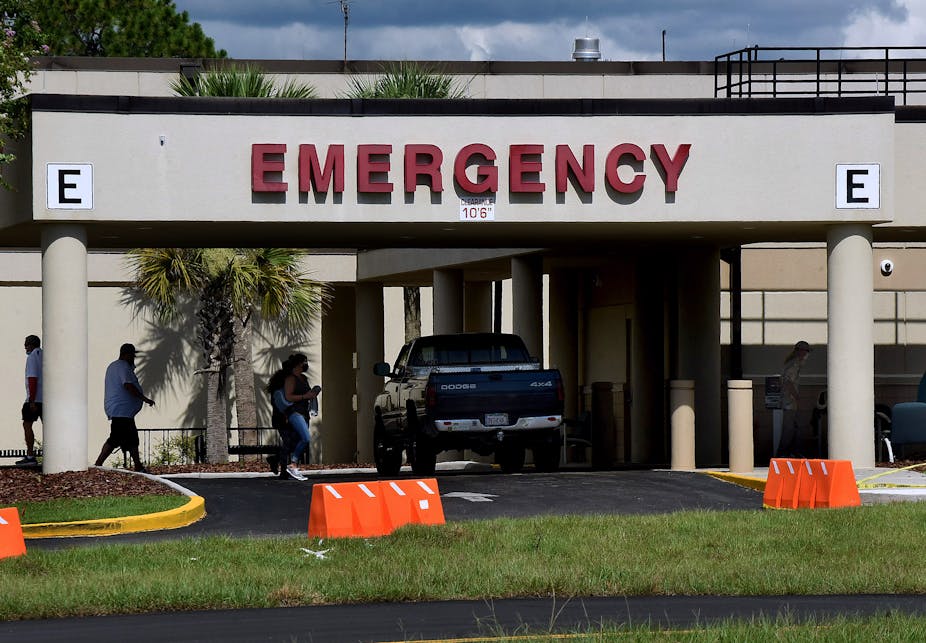The number of unfilled positions in emergency medicine residency programs surged in 2022 and 2023, with the trend most pronounced at programs that were recently accredited or under for-profit ownership. That’s the key finding of my team’s recent study of the past two match cycles.
A match cycle is when medical students choose a specialty and learn where they will train. It starts when fourth-year medical students interview at residency programs at hospitals around the country. Then, the students rank their preferred training programs, and the programs rank the students. An algorithm makes matches.

The proportion of medical students applying for emergency medicine residencies dropped by 16.8% from 2021 to 2022 and declined another 18.1% from 2022 to 2023. This abrupt decline may degrade the three-to-four-year clinical training experience of emergency medicine residents and affect how the health care system provides emergency care in the future.
But this waning in demand is only half of the story. Deepening the problem is the fact that the number of emergency medicine residency programs has grown at the same time.
No checks on the for-profit sector
Over the past five to eight years, more for-profit and private capital-backed firms have bought emergency medicine facilities, taken over staffing contracts in existing hospitals and created emergency residency programs.
Since they are for-profit entities, these companies have a responsibility to return money to investors. They have been shown to achieve this by paying residents less and charging higher prices on services like imaging and hospitalization.

Currently, there are no limits on the number of residency programs or positions in emergency medicine. The Review Committee for Emergency Medicine automatically approves all proposals for new residency programs that meet requirements. Despite the fact that positions are already going unfilled, eight new emergency medicine residency programs were accredited during the 2022-23 academic year. This accreditation system is currently under review, but any changes will take years to go into effect.
More positions, lower demand
I am a physician who studies the state of emergency care. In our recent paper, my team and I calculated the number of emergency medicine residency programs that filled all positions in the past two match cycles.
Our study shows that in 2022, 277 emergency medicine residency programs offered 2,921 positions and had 219 unfilled positions. In 2023, 287 emergency medicine programs offered 3,010 positions and 554 went unfilled. In each of these years, about 30 programs had primary clinical training sites under for-profit ownership.
The drop in interest in emergency medicine may be driven by well-circulated forecasts predicting a surplus in the emergency physician workforce by 2030 and escalating levels of burnout among emergency physicians.
By examining where residents chose to go when there were more than enough programs to choose from, we learned three things.
First, more established programs did better. Emergency medicine residency programs accredited within the past five years had more than double the likelihood of not filling all positions compared with those accredited for more than five years.
Second, in 2023, more opportunities were offered in several metropolitan areas, including Detroit, Miami and Philadelphia, but these programs ended up with many unfilled positions.
Third, emergency medicine residency programs with for-profit clinical sites were less likely to fill all residency positions. These programs had a 50% greater chance of not filling all positions when compared with nonprofit or government-run sites.
Possible solutions
It’s not clear whether these trends will continue. In 1996, the anesthesiology specialty saw the proportion of filled residency positions drop to 45%, an all-time low. Yet the specialty rebounded to fill nearly 100% of available positions by 2002.
While it is possible the past two years for emergency medicine are part of the natural ebb and flow of specialty interest among medical students, our findings, the historical literature and the recent bankruptcy filing of Envision – a large, for-profit emergency medicine group that staffs several clinical sites and residency programs – all suggest medical students may be recognizing the disadvantages of for-profit emergency medicine residency programs.
There is little data on the quality of these programs. No research yet has evaluated board exam pass rates of emergency medicine residents graduating from newly accredited or for-profit clinic sites. However, residents in pediatric programs with a corporate affiliation had lower board exam pass rates.
In addition to reconsidering the persistent opening of new programs, now may be the time for organizations like the Emergency Medicine Residents’ Association and the American College of Emergency Physicians to address issues that affect recruitment of emergency medicine residents.
Physician burnout could be addressed by reviewing hospital policies designed to maximize profits. For example, many patients are admitted to the hospital, yet “board” in the hallway of an emergency department for hours. These patients have routinely been shown to have worse outcomes, yet hospital leadership frequently attempts to prioritize revenue-generating surgeries and procedures in lieu of assigning beds for admitted patients from the emergency department.
Loan forgiveness and increased salaries could draw more residents to emergency medicine, especially in rural areas where distinct physician shortages exist. And more female residents would be drawn into emergency medicine if disparities in pay and concerns over violence in emergency rooms were systematically resolved.

